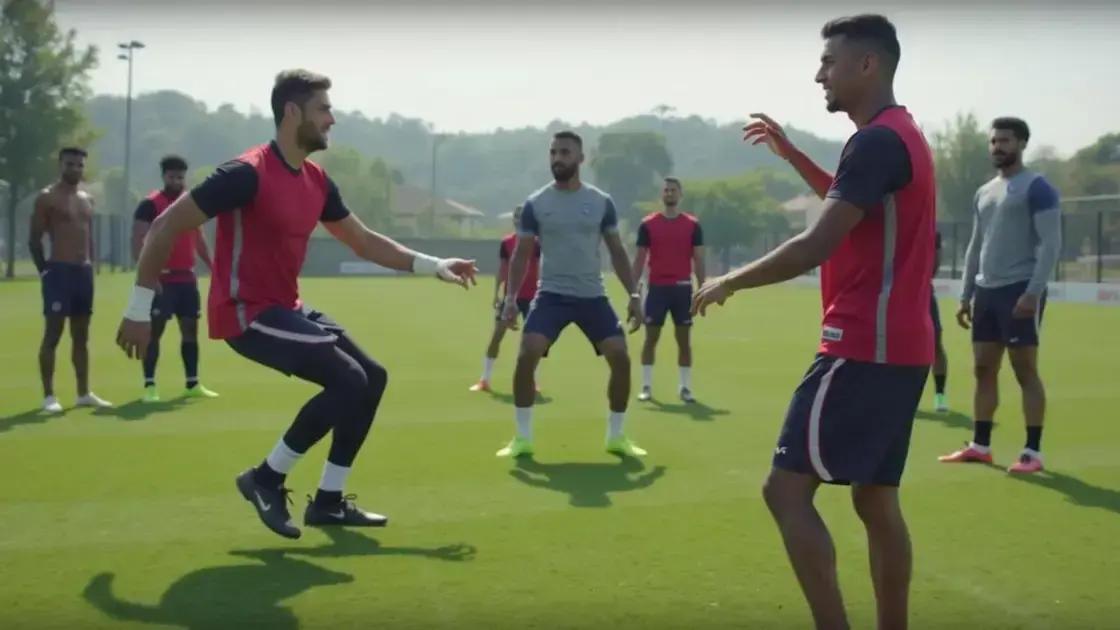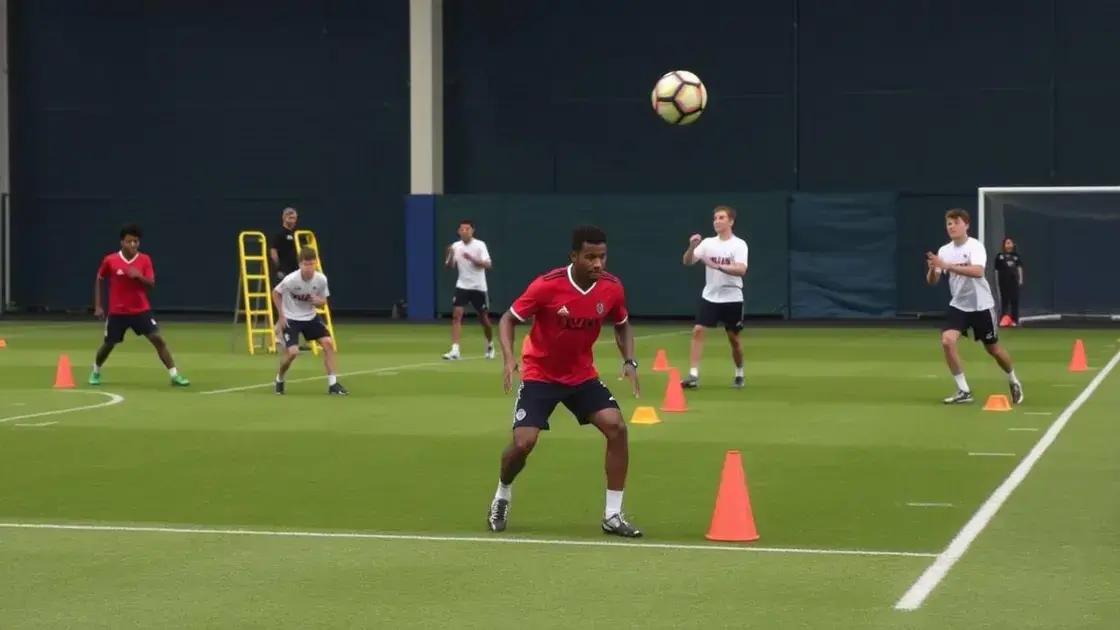To build coordination with sequential movement drills, focus on exercises like ladder drills, cone drills, and ball toss drills, ensuring you set clear goals, practice consistently, and vary your training for optimal results.
Building coordination is essential for athletes and anyone looking to improve their physical skills. How to build coordination with sequential movement drills will help enhance various athletic capacities. Sequential movement drills involve a series of movements performed in a specific order to develop balance, agility, and overall motor skills. In this post, we’ll delve into the benefits of these drills, explore some effective exercises, and provide tips for ensuring successful training sessions.
Understanding Sequential Movement Drills

Understanding Sequential Movement Drills is crucial for any athlete or individual looking to enhance their coordination skills. Sequential movement drills involve a series of actions or movements that are performed in a specific order. These drills are designed to train the body to move smoothly and efficiently from one movement to the next.
In these drills, the focus is on timing, rhythm, and precision. For example, a common drill may involve running forward, then side-stepping, followed by a jump or a quick change of direction. The goal is to perform these movements seamlessly, which helps to improve motor skills and overall athletic performance.
Key Components of Sequential Movement Drills
Sequential movement drills often include several key components:
- Progression: Start with simple movements and gradually increase complexity as the athlete becomes more comfortable.
- Repetition: Consistent practice is necessary to develop muscle memory and improve coordination.
- Variety: Incorporating different types of movements keeps training interesting and engages various muscle groups.
By understanding these components, athletes can better design their training routines to focus on improving their coordination through sequential movement drills.
Benefits of Coordination Training

Benefits of Coordination Training are numerous and impactful for athletes and individuals in any physical activity. Coordination training enhances the ability to move various body parts together smoothly, which is essential for improving overall performance in sports.
One of the key benefits is improved balance. Better coordination can lead to greater stability, reducing the risk of falls and injuries during activity. Athletes with strong coordination skills often demonstrate better body control during complex movements, such as jumping, running, and turning.
Another advantage is increased agility. Training coordination prepares the body for quick changes in direction, allowing athletes to react faster in competitive situations. This enhanced agility is vital in many sports, from soccer to basketball.
Enhanced Motor Skills
Coordination training also leads to improved motor skills. As athletes practice specific movements, they develop muscle memory, making it easier to perform complex tasks automatically. This efficiency allows for better focus on strategy and gameplay rather than the mechanics of movement.
Boosted Confidence
As coordination improves, athletes often experience a boost in confidence. Knowing they can execute movements effectively helps them perform better in games and competitions. This confidence translates to a positive mindset, helping with motivation and performance consistency.
Finally, coordination training can be a lot of fun! By incorporating diverse drills and exercises, individuals are more likely to enjoy their workouts and stay engaged in their training routine. This enjoyment can further enhance participation and retention in physical activities.
Best Drills for Improving Coordination

To improve coordination, incorporating specific drills into your training routine can make a significant difference. Here are some of the best drills for improving coordination.
1. Ladder Drills
Ladder drills help enhance foot speed and agility. Set up an agility ladder on the ground and practice moving through the rungs in various patterns, like high knees, side steps, and in-and-out motions. This drill engages your entire body and improves your ability to control movements.
2. Cone Drills
Using cones to create a course can develop coordination and quickness. Arrange cones in a zigzag pattern and practice running through them while maintaining control over your body movements. It’s helpful for developing directional changes, speed, and focus.
3. Ball Toss Drills
Ball toss drills train hand-eye coordination. Pair up with a partner and toss a ball back and forth. Try varying speeds and directions to increase the challenge. You can also incorporate catching drills using different types of balls to improve reaction time and focus.
4. Balance Exercises
Enhancing balance is crucial for coordination. Practice standing on one leg, using a balance board, or walking along a straight line. These exercises build stability and control, essential components of coordination.
5. Shadow Drills
Shadow drills involve mimicking the movements of a partner or coach. This exercise improves response time and helps develop the ability to anticipate movements. Focus on coordinating your steps, arm movements, and overall body flow while following your partner.
Incorporating these drills into your regular practice can significantly boost your coordination and overall athletic performance. Remember to maintain proper form and gradually increase the complexity to keep challenging yourself.
Tips for Effective Practice Sessions

To get the most out of your practice sessions, here are some tips for effective practice sessions that can help boost your coordination skills.
1. Set Clear Goals
Before each session, define what you want to achieve. Whether it’s perfecting a specific drill or increasing speed, having clear goals helps you stay focused and motivated.
2. Warm Up Properly
Always begin with a warm-up to prepare your body for physical activity. This can include light jogging, dynamic stretches, and mobility exercises to ensure your muscles are ready.
3. Incorporate Variety
To prevent boredom and enhance learning, include a mix of drills in your practice. Try different exercises that target coordination but also challenge speed and agility.
4. Focus on Technique
While it’s tempting to rush through drills to increase intensity, focus on proper form. Good technique is essential for building correct muscle memory and avoiding injuries.
5. Use a Timer
Introducing a timer can add a fun challenge to your sessions. Set limits for each drill and strive to improve your time with each session, promoting a sense of urgency and accomplishment.
6. Reflect After Each Session
Take a few minutes to evaluate your practice. Note what worked well and what didn’t. This reflection helps you adjust your future sessions to ensure continuous improvement.
7. Stay Hydrated
Drinking water is crucial during practice. Staying hydrated helps maintain energy levels and improves overall performance.
8. Celebrate Small Wins
Recognize and celebrate progress, no matter how small. Achievements boost motivation and encourage a positive attitude towards practice.
By applying these tips, you can optimize your practice sessions and see noticeable improvements in your coordination skills over time.
In Conclusion: Enhancing Coordination Through Practice
Improving coordination is crucial for athletes and anyone engaged in physical activities. Through understanding sequential movement drills and incorporating effective practice sessions, individuals can significantly enhance their coordination skills.
By acknowledging the benefits of coordination training and regularly practicing the best drills, you’ll experience improvements in balance, agility, and overall motor skills. Remember to apply the tips for effective practice sessions, as these can help maximize your training results.
With commitment and the right techniques, you can unlock your potential and improve your performance in sports and beyond.
FAQ – Frequently Asked Questions about Building Coordination with Sequential Movement Drills
What are sequential movement drills?
Sequential movement drills are a series of coordinated actions performed in a specific order to improve balance, agility, and overall coordination.
How can I benefit from coordination training?
Coordination training enhances balance, agility, and motor skills, reducing the risk of injuries and improving overall athletic performance.
What are some effective drills to improve coordination?
Effective drills include ladder drills, cone drills, ball toss drills, balance exercises, and shadow drills to target different aspects of coordination.
How long should I practice coordination drills?
Aim for at least 20-30 minutes per practice session, focusing on different drills to maintain engagement and target various coordination skills.
How can I track my progress in coordination training?
Keep a training log to track the drills you perform, the duration of practice, and any improvements in speed or technique over time.
What tips can help make my practice sessions more effective?
Set clear goals, warm up properly, involve variety in drills, focus on technique, use a timer, reflect after sessions, stay hydrated, and celebrate small wins.













